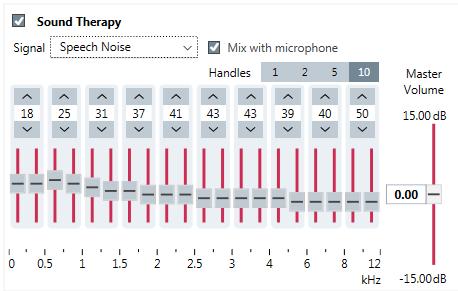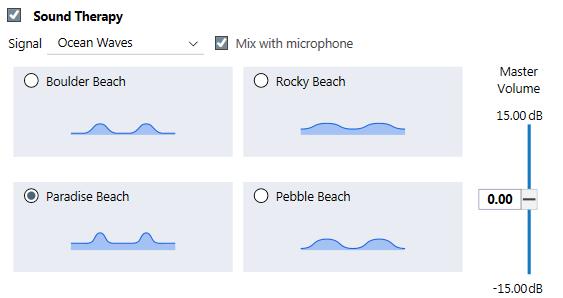Signia Tinnitus Therapy Options
Tinnitus and hearing loss often go hand-in-hand. For those patients whose tinnitus is not mitigated by amplification alone, Signia hearing aids offer hearing care professionals three types of tinnitus therapy approaches to customize for each patient. Static Noise and Ocean Wave signals are both sound therapy approaches that have been proven to provide relief for many tinnitus patients, especially when combined with established therapy approaches such as Tinnitus Activities Treatment (TAT) or Tinnitus Retraining Therapy (TRT) (see Powers & dos Santos, 2015). Notch Therapy is a new and proprietary method proven to be especially effective for the relief of tonal tinnitus (See Powers & dos Santos, 2016).
Static Noise
Signia offers five static noise presets including: white noise, pink noise, Brownian noise, high-tone noise, and Speech noise. In addition to these, the hearing care professional can also customize a static noise for the patient by adjusting the noise frequency response in up to 20 handles depending on the hearing aid performance level. It is also possible to either mix the noise together with the microphone signal, or set up a noise-only program without microphone input.
The hearing care professional is encouraged to choose the type of static noise according to his tinnitus treatment approach. Since the patient will most likely be listening to the therapy noise for an extended amount of time, her preferences should also be considered in the fitting process. Some hearing care professionals prefer to set up a Universal program combined with a static noise for everyday use, and a separate noise-only program for quiet occasions (such as reading) when tinnitus may become more bothersome.

Modulated Noise: Ocean Waves
The other category of sound therapy Signia hearing aids provide are different modulated noise presets that approximate ocean waves crashing on the beach. The four Ocean Wave signals are named after different types of beaches, and differ primarily in terms of the intensity and frequency of the modulation, or breaking waves.
The new Paradise Beach signal was developed together with world-renowned tinnitus treatment authority Dr. Pawel Jastreboff. One of its advantage is that it is not a fully modulated signal, so there are no “silence gaps” between successive waves when tinnitus may become audible. With this measure, we ensure that that patient’s attention is not drawn back to the tinnitus. Therefore, when helping patients to select the best Ocean Wave signal, Paradise Beach may be presented as a first option, followed by Rocky Beach, which is also not fully modulated, and then Boulder or Pebble Beach.
For those patients who were fit with Sandy Beach in the past and prefer a similar signal, Boulder Beach, which is closest to Sandy beach in spectral characteristics, or Pebble Beach may be used instead. Just like when working with static noise, the ultimate selection of a particular type of Ocean Wave signal should depend heavily on the preference of the individual patient.
In cases of tinnitus associated with stress, some patients have found better results with the more organic Ocean Wave signals than static noise. In general, however, research has not shown one type of sound to be more effective than the other.

Notch Therapy
Tonal tinnitus, which includes all types of pure-tone like whistling, ringing or humming, is the most common form of tinnitus. Unlike traditional sound therapy which introduces another acoustic stimulus to the patient, Notch Therapy is inaudible and works in the background to relieve the annoyance of tinnitus. By simply wearing the hearing aids with Notch Therapy activated throughout the day, patients have experienced relief from tinnitus in as few as three weeks.
Based on the concept of “re-attracting” lateral inhibition, Notch Therapy aims to attack tinnitus on two fronts: 1) enhancing the auditory environment by amplification, 2) suppressing the tinnitus associated neural hyperactivity with enhanced lateral inhibition. Notch Therapy is customized to the patient by locating the frequency of the patient’s tonal tinnitus frequency. This can be accomplished in a few simple steps with Connexx® fitting software (See Powers & Herbig, 2017).
Availability
Static Noise, Ocean Wave, and Notch Therapy are available in most Signia primax™ hearing instruments.
Find out more
Visit:
https://www.signia-pro.com/tinnitus/
Read:
Powers, L. & Herbig, R. (2017). Notch Therapy Quick Guide. Signia Publication.
Powers, L., & dos Santos, G. M. (2015). Acoustic Therapy for the Treatment of Tinnitus: A Primer. Hearing Review, 22(6), 22.
Powers, L., dos Santos, G. M. , & Jons, C. (2016). Notch Therapy: A new approach to tinnitus treatment. AudiologyOnline, Article 18365. Retrieved from www.audiologyonline.com.
Wolf, V. (2016). How to Use primax Tinnitus Therapy Options. Signia Whitepaper.
Watch:
Tinnitus customer testimonial: https://www.youtube.com/watch?v=KV8brQQlv9o